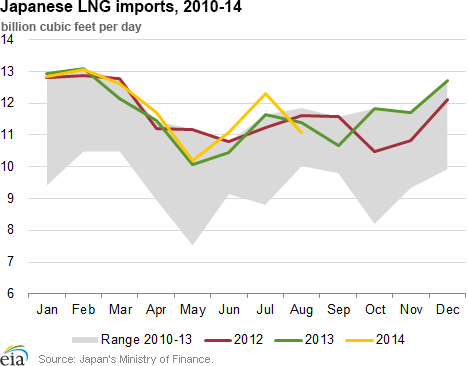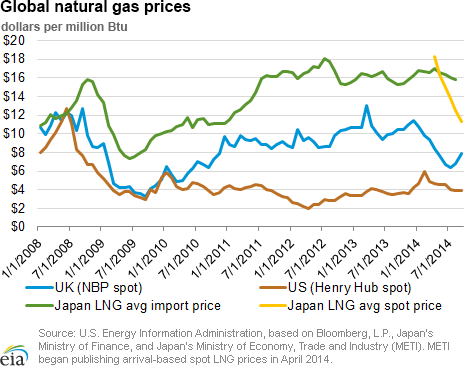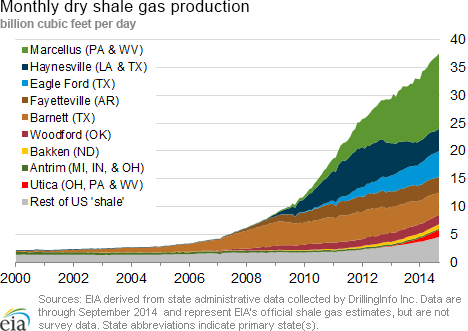In the News:
Japan continues to import record volumes of LNG amid delays in nuclear restarts
Japan's imports of liquefied natural gas (LNG) remained at a near-record average of 11.85 billion cubic feet a day (Bcf/d) in the first eight months of 2014, according to recently released trade statistics from Japan's Ministry of Finance. Increased LNG imports are occurring amid continued shutdowns of nuclear power plants following the March 2011 disaster at the Fukushima Daiichi nuclear power plant and the subsequent increased use of fossil fuels in power generation. Higher levels of LNG imports in 2014 are underpinned by continuous growth in gas-fired power generation, the ready availability of spot LNG supply because of weak demand in Europe and Asia (particularly in South Korea) and lower short-term prices.
Higher consumption of fossil fuels for power generation following the nuclear meltdown contributed to already high energy costs and led to record trade deficits. Japanese utilities have been reducing the share of crude oil and heavy fuel oil in the power generation mix, while increasing coal consumption with the start-up of new coal-fired plants. In 2013, coal consumption for power generation increased by 16% over 2012, and reached a record 40 million tons in the first eight months of 2014. LNG consumption also remains at near-record levels, supported by more than 2.5 GW of new gas-fired power generating capacity commissioned in 2014 and a growing demand in the industrial sector driven by oil-to-gas substitution.
At present, all of Japan's 48 nuclear reactors (which generated 34% of the country's power in 2010) remain offline, and the timeline for their restarts remains uncertain. Last month, Japan's Nuclear Regulation Authority approved a safety report of two reactors—Kyushu Electric Power Company's Sendai reactors No. 1 and 2—bringing them a step closer to a restart in the next few months. However, strict safety standards for nuclear plant restarts combined with strong public opposition to nuclear power may delay the restarts of the plants.
Since 2012, the increase in Japan's LNG consumption has averaged around 2.3 Bcf/d compared with 2010. That increase is nearly equal to the total LNG import volume of the world's third-largest LNG importer, China, which imported 2.5 Bcf/d in 2013. The incremental supply to accommodate Japan's increase was diverted primarily from Europe, where LNG consumption declined by 4.1 Bcf/d (48%) in 2013 compared with 2010. Increased use of existing liquefaction capacity, particularly in Qatar and Australia, also contributed to the incremental supply.
Additionally, the commissioning of the Papua New Guinea liquefaction plant in May, which coincided with lower demand in Europe, contributed to more spot supply available to Asian buyers.
In South Korea, warmer-than-average winter temperatures and near-full storage levels going into summer prompted the Korean Gas Corporation to seek buyers or swap partners for 20-40 cargos to manage lower-than-expected demand. Reduced competition from South Korea increased supply and reduced prices in Asia Pacific markets.
These factors contributed to lower average LNG import prices in Japan in the second half of the year, and were coupled with higher LNG import volumes. Japan's spot LNG prices averaged $13.77/MMBtu in June-August and declined to $11.30/MMBtu in September. While Japanese spot prices have been trending lower in the second half of 2014, they still remain significantly above natural gas prices in other regions (see chart).
Overview:
(For the Week Ending Wednesday, October 15, 2014)
- Spot prices fell over the report week at most market locations, with northeastern pricing points reaching record lows in Friday trading before reversing losses at the end of the report week (Wednesday-to-Wednesday). The Henry Hub spot price fell from $3.88 per million British thermal units (MMBtu) last Wednesday, October 8, to $3.82/MMBtu yesterday.
- At the New York Mercantile Exchange (Nymex), the near-month (November 2014) contract shed five cents, falling from $3.855/MMBtu last Wednesday to $3.800/MMBtu yesterday.
- Working natural gas in storage rose to 3,299 billion cubic feet (Bcf) as of Friday, October 10, according to the U.S. Energy Information Administration (EIA) Weekly Natural Gas Storage Report (WNGSR). A net increase in storage of 94 Bcf for the week resulted in storage levels 9.4% below year-ago levels and 9.9% below the five-year average for this week.
- The total rotary rig count as of October 10 was 1,930 active units, an increase of 8 from the previous week, according to data from Baker Hughes Inc. The natural gas rig count declined by 10 from the previous week to 320 active units. The oil rig count increased by 18 units to 1,609.
- The Mont Belvieu natural gas plant liquids composite price declined 3.5%, or 33 cent, to $9.14/MMBtu for the week covering October 6 - October 10. All components of the price fell, with natural gasoline, propane, isobutane, butane, and ethane falling 5.7%, 3.5%, 2.7%, 2.0%, and 1.4%, respectively. The decline in plant liquids prices has generally followed the steep decline in oil prices over the past couple of weeks.
Prices/Demand/Supply:
Natural gas prices declined at most locations over the report week. Prices fell this week as mild October weather kept demand moderate. The Henry Hub spot price fell from $3.88/MMBtu last Wednesday to $3.82/MMBtu yesterday. Prices at other major points around the country followed the same pattern, as temperatures across much of the Lower 48 states were mild, without high demand for either heating or cooling. Prices at the Chicago Citygate fell from $3.96/MMBtu last Wednesday to $3.78/MMBtu yesterday; PG&E Citygate prices (serving Northern California) fell from $4.41/MMBtu last Wednesday to $4.31/MMBtu yesterday.
Northeast prices drop to new lows on Friday. At Transcontinental Pipeline’s Zone 6 trading point for delivery into New York City, prices dropped to $1.37/MMBtu on Friday, their lowest level in the available data history from 1998. Ten months ago, the price at Transco Zone 6 hit its record high at $121.68/MMBtu in January. Prices at the Algonquin Citygate, serving Boston, also fell to a record low of $1.69/MMBtu on Friday. Like New York, the Algonquin Citygate hit its high earlier this year as well, reaching $78.30/MMBtu in January. Decreases were likely the result of strength in supply as well as forecasts for mild demand over the weekend. New York and Boston prices rebounded in trading Monday, and New York ended the week at $2.06/MMBtu, up 8 cents from the previous Wednesday. Boston prices ended at $3.08/MMBtu, a decline of 26 cents from the previous Wednesday.
Marcellus prices post overall gains. Like Boston and New York prices, Marcellus-area prices dropped substantially on Friday. Prices on Transcontinental’s Leidy Line, which runs from central Pennsylvania to New Jersey, fell from $1.86/MMBtu at the beginning of the report week to $1.43/MMBtu on Friday. Prices at Leidy rebounded and ended the report week at $2.00/MMBtu, up 14 cents from the previous Wednesday, but still comparatively low. Similarly, prices on Tennessee Pipeline’s Zone 4 Marcellus line dropped to $1.40/MMBtu on Friday, but ended the week up 18 cents at $1.93. Since the summer of 2012, rising growth in natural gas production in the Marcellus has outpaced growth in the region’s available pipeline takeaway capacity. As a result, the Marcellus region's natural gas prices have declined. Various pipeline projects have been proposed to provide more takeaway capacity to the area. This week, Spectra Energy filed a request with the Federal Energy Regulatory Commission to put into service 510 MMcf/d of its 0.6 Bcf/d Texas Eastern to Appalachia-to-Market project, which will flow gas from the Marcellus to market areas in the Gulf Coast.
Supply remains well above a year ago. Natural gas dry production fell by 0.1% this week, but remained 7.1% greater than year-ago levels. Canadian imports to the Midwest increased by 11.3%, likely to meet heating demand in the Upper Midwest. While much of the country experienced mild weather, low temperatures dropped into the 30s this week in the more northern parts of the Lower 48 states. LNG sendout remained at minimal levels.
Demand increases slightly. Total demand rose 0.8% week over week. Residential and commercial consumption increased 3.3% from the previous week, while industrial rose 1.5%, and consumption of natural gas for power generation fell 1.6%.
Nymex falls during the week. The near-month (November 2014) price fell from $3.855/MMBtu last Wednesday to $3.800/MMBtu yesterday. The November contract has lost 35 cents since it began its tenure as the near-month contract on September 29. The price of the 12-month strip (the 12 contracts between November 2014 and October 2015) fell from $3.840/MMBtu to $3.789/MMBtu.
Storage
Net injection moves storage within 10% of the 5-year average for the first time this year. The net injection reported for the week ending October 10 was 94 Bcf, 16 Bcf larger than the five-year average net injection of 78 Bcf and 15 Bcf larger than last year's net injection of 79 Bcf. Working gas inventories totaled 3,299 Bcf, 344 Bcf (9.4%) less than last year at this time and 362 Bcf (9.9%) below the five-year (2009-13) average.
Storage build higher than expectations. Market expectations called for an average build of 91 Bcf. When the EIA storage report was released at 10:30 a.m., the price for the November natural gas futures contract fell 5 cents to $3.76/MMBtu in trading on the Nymex.
From the week ending on April 4 through the week ending on October 10, net storage injections totaled 2,477 Bcf versus 1,943 Bcf for the same 28 weeks in 2013, and 1,847 Bcf for these weeks between 2009 and 2013, on average. The average unit value of what storage holders put into storage from April 4 to October 10 was $4.26/MMBtu, 13% higher than the average value for the same 28 weeks last year of $3.76/MMBtu. The highest winter-month Nymex price (for the January 2015 contract) in trading for the week ending on October 10 averaged $4.09/MMBtu. This is 17 cents more than the current front month Nymex contract price for that week. A year ago, the difference was 27 cents/MMBtu.
There currently are three more weeks in the injection season, which traditionally occurs April 1 through October 31, although in each of the past 11 years, injections continued into November. EIA forecasts that the end-of-October working natural gas inventory level will be 3,532 Bcf, which, as of October 7, would require an average injection of 78 Bcf per week through the end of October. EIA's forecast for the end-of-October inventory levels are below the five-year (2009-13) average peak storage value of 3,851 Bcf.
All regions post larger-than-average builds. The East, West, and Producing regions had net injections of 49 Bcf (7 Bcf larger than its five-year average), 10 Bcf (3 Bcf larger than its five-year average), and 35 Bcf (7 Bcf larger than its five-year average), respectively. Storage levels for all three regions remain below their year-ago and five-year average levels.
Temperatures during the storage report week were less than a degree warmer than the 30-year average. Temperatures in the Lower 48 states averaged 61.1 degrees for the week, 0.6 degree warmer than the 30-year normal temperature and 3.0 degrees cooler than during the same period last year. There were 23 population-weighted cooling degree days during the storage report week, 5 more than the 30-year normal and 2 less than the same period last year. There were also 50 population-weighted heating degree days during the storage report week, 1 more than the 30-year normal and 19 more than the same period last year.
See also:
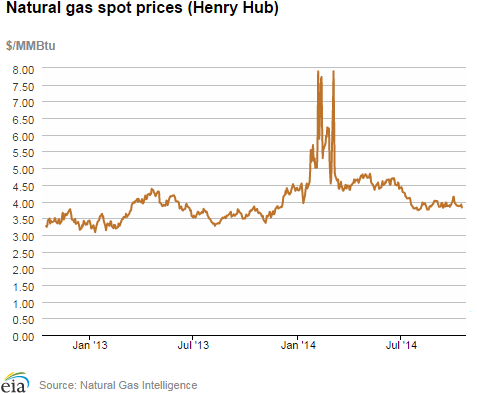
| Spot Prices ($/MMBtu) | Thu, 09-Oct |
Fri, 10-Oct |
Mon, 13-Oct |
Tue, 14-Oct |
Wed, 15-Oct |
|---|---|---|---|---|---|
| Henry Hub |
3.86 |
3.86 |
3.87 |
3.91 |
3.82 |
| New York |
1.83 |
1.37 |
2.03 |
2.13 |
2.06 |
| Chicago |
3.96 |
3.92 |
3.84 |
3.89 |
3.78 |
| Cal. Comp. Avg,* |
4.04 |
3.96 |
4.05 |
4.07 |
3.96 |
| Futures ($/MMBtu) | |||||
| November Contract |
3.845 |
3.859 |
3.916 |
3.816 |
3.800 |
| December Contract |
3.937 |
3.949 |
4.004 |
3.900 |
3.885 |
| *Avg. of NGI's reported prices for: Malin, PG&E citygate, and Southern California Border Avg. | |||||
| Source: NGI's Daily Gas Price Index | |||||
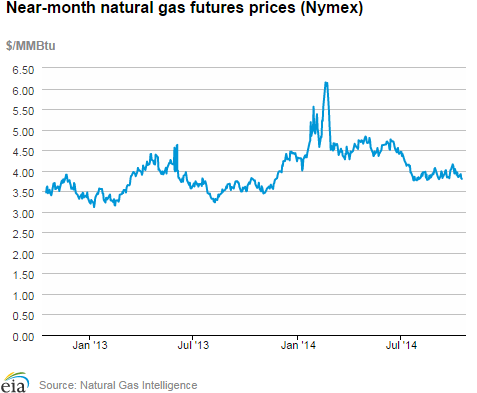
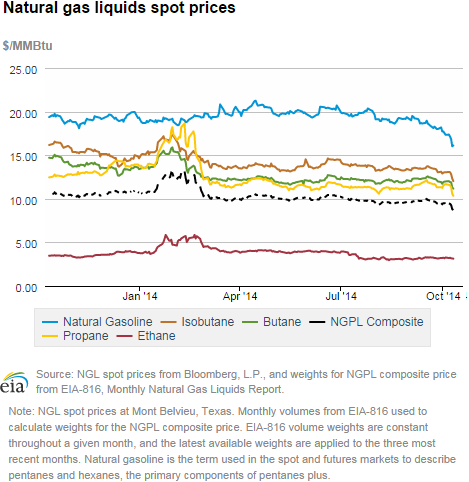
| U.S. Natural Gas Supply - Gas Week: (10/8/14 - 10/15/14) | ||
|---|---|---|
Percent change for week compared with: |
||
last year |
last week |
|
| Gross Production | 7.22%
|
-0.09%
|
| Dry Production | 7.15%
|
-0.09%
|
| Canadian Imports | 24.61%
|
7.20%
|
| West (Net) | 14.23%
|
-0.44%
|
| MidWest (Net) | 43.23%
|
11.28%
|
| Northeast (Net) | 354.32%
|
-31.99%
|
| LNG Imports | -88.38%
|
65.52%
|
| Total Supply | 8.02%
|
0.42%
|
| Source: BENTEK Energy LLC | ||
| U.S. Consumption - Gas Week: (10/8/14 - 10/15/14) | ||
|---|---|---|
Percent change for week compared with: |
||
last year |
last week |
|
| U.S. Consumption | 5.2%
|
0.8%
|
| Power | 9.3%
|
-1.6%
|
| Industrial | 1.1%
|
1.5%
|
| Residential/Commercial | 5.0%
|
3.3%
|
| Total Demand | 5.6%
|
0.8%
|
| Source: BENTEK Energy LLC | ||
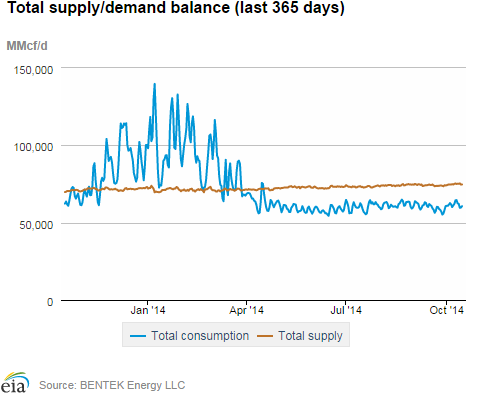
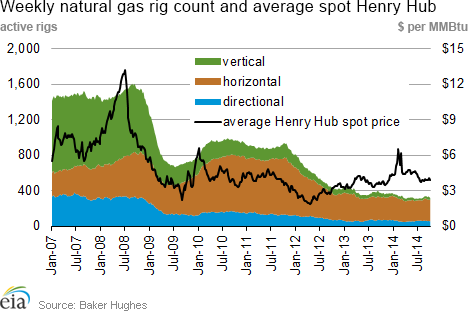
| Rigs | |||
|---|---|---|---|
Fri, October 10, 2014 |
Change from |
||
last week |
last year |
||
| Oil Rigs | 1,609 |
1.13% |
17.70% |
| Natural Gas Rigs | 320 |
-3.03% |
-13.28% |
| Miscellaneous | 1 |
0.00% |
-85.71% |
| Rig Numbers by Type | |||
|---|---|---|---|
Fri, October 10, 2014 |
Change from |
||
last week |
last year |
||
| Vertical | 370 |
-0.54% |
-9.54% |
| Horizontal | 1,353 |
0.89% |
22.33% |
| Directional | 207 |
-0.96% |
-9.21% |
| Source: Baker Hughes Inc. | |||
| Working Gas in Underground Storage | ||||
|---|---|---|---|---|
Stocks billion cubic feet (bcf) |
||||
| Region | 2014-10-10 |
2014-10-03 |
change |
|
| East | 1,825 |
1,776 |
49 |
|
| West | 474 |
464 |
10 |
|
| Producing | 1,000 |
965 |
35 |
|
| Total | 3,299 |
3,205 |
94 |
|
| Source: U.S. Energy Information Administration | ||||
| Working Gas in Underground Storage | |||||
|---|---|---|---|---|---|
Historical Comparisons |
|||||
Year ago (10/10/13) |
5-year average (2009-2013) |
||||
| Region | Stocks (Bcf) |
% change |
Stocks (Bcf) |
% change |
|
| East | 1,890 |
-3.4 |
1,976 |
-7.6 |
|
| West | 544 |
-12.9 |
511 |
-7.2 |
|
| Producing | 1,209 |
-17.3 |
1,173 |
-14.7 |
|
| Total | 3,643 |
-9.4 |
3,661 |
-9.9 |
|
| Source: U.S. Energy Information Administration | |||||
| Temperature -- Heating & Cooling Degree Days (week ending Oct 09) | ||||||||
|---|---|---|---|---|---|---|---|---|
HDD deviation from: |
CDD deviation from: |
|||||||
| Region | HDD Current |
normal |
last year |
CDD Current |
normal |
last year |
||
| New England | 68
|
-10
|
24
|
0
|
0
|
0
|
||
| Middle Atlantic | 53
|
-13
|
30
|
0
|
-3
|
-12
|
||
| E N Central | 93
|
23
|
58
|
0
|
-3
|
-15
|
||
| W N Central | 94
|
27
|
39
|
0
|
-5
|
-9
|
||
| South Atlantic | 32
|
-1
|
19
|
32
|
-4
|
-21
|
||
| E S Central | 35
|
4
|
19
|
18
|
-3
|
-17
|
||
| W S Central | 8
|
-1
|
-6
|
59
|
16
|
6
|
||
| Mountain | 48
|
-20
|
-33
|
20
|
0
|
8
|
||
| Pacific | 3
|
-20
|
-16
|
50
|
36
|
41
|
||
| United States | 50
|
1
|
19
|
23
|
5
|
-2
|
||
|
Note: HDD = heating degree-day; CDD = cooling degree-day Source: National Oceanic and Atmospheric Administration | ||||||||
Average temperature (°F)
7-Day Mean ending Oct 09, 2014
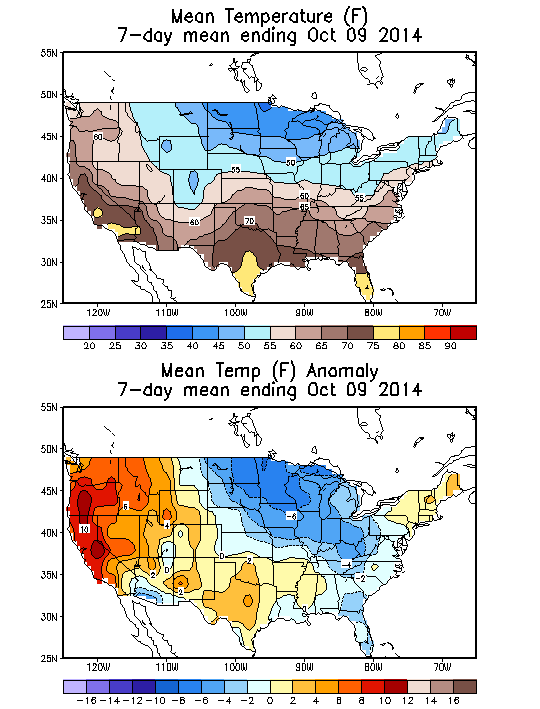
Source: NOAA/National Weather Service
Deviation between average and normal (°F)
7-Day Mean ending Oct 09, 2014

Source: NOAA/National Weather Service

